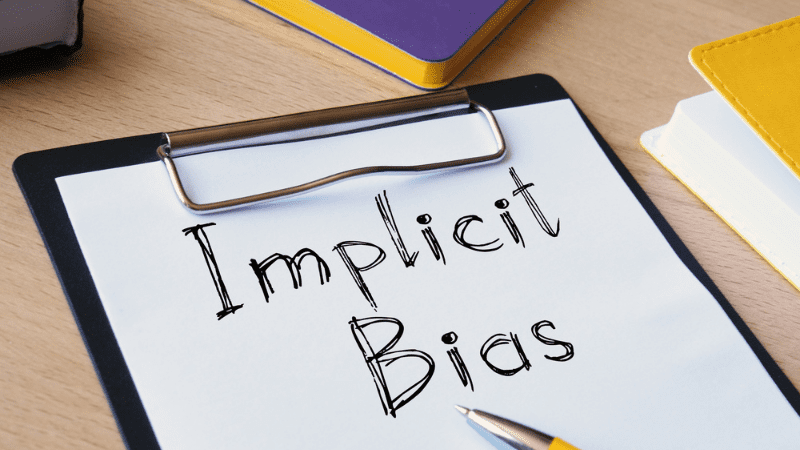As teachers, we place high value on treating our students equally and fairly. We strive to create classrooms where kids feel safe, seen, and wanted. With that in mind, it can be scary to be asked to examine our subconscious biases. When I first took implicit bias tests, I was nervous about the results. Would they reveal ugly aspects of myself that I wasn’t even conscious of? It is never comfortable to examine what stereotypes or biases we might hold on to, but part of growing as an individual is doing just that. By accepting the discomfort of examining our own biases, we have nothing to lose but potentially harmful beliefs. And by doing so, we continue the journey toward becoming the honest, self-aware teachers our students need and deserve.
What are implicit biases?

Implicit biases are unconscious attitudes and stereotypes that can manifest in our schools, our justice and healthcare systems, and in our daily lives.
Implicit biases aren’t necessarily harmful or bad. We are pummeled with information every second of our waking lives. The brain’s job is to make sense of it all. But we’re really only consciously aware of a very tiny chunk of that information. The rest of it doesn’t go away, however. The brain sorts it all into patterns and groupings that make sense based on our previous experiences. But this is all done unconsciously. Because of this, we sometimes respond to situations not because we consciously choose to, but rather because of subconscious patterns our brain has created for us.
Why can implicit biases be harmful?
Surveys indicate that overtly racist opinions are on a steady decline. For example, in 1960, over 50 percent of white Americans surveyed stated they would move if a Black family moved in next door. In 2021, that number was 6 percent. If this were the end of the story, that would be wonderful, but examples of racist, sexist, and other prejudiced behaviors and attitudes persist.
Job-seekers with distinctively Black names continue to receive significantly fewer interview requests than their white named counterparts. And when men and women both express the same amount of pain to medical staff (i.e., doctors, nurses, etc.), medical personnel are far more likely to downplay the woman’s pain than the man’s.
Implicit bias is a possible answer to the question of why incidents like these continue. While we may fully believe that we do not harbor negative views toward any particular group of people, our subconscious biases may be causing us to act in negative ways we aren’t even fully aware of.
If they’re subconscious, how do implicit bias tests reveal biases?
The tests show test-takers a series of words or images and measure how fast each person makes connections between them. The hypothesis being that people make faster pairings when their subconscious beliefs connect the two items. So, for example, someone with an implicit bias toward males in high-powered positions would be more likely to link a photograph of a man in a suit with the word “CEO” than they might if the photo was of a woman in a dress.
What will my implicit bias test results show me?
The researchers who created the Implicit Association Test (IAD) are quick to explain that the test results will not identify someone overtly racist or sexist. Instead, they may reveal slight preferences a person may have subconsciously. So, for example, a result might state that a person displayed a “slight preference for white faces over Black faces.”
Isn’t there some controversy over the effectiveness of implicit bias tests?
There is. Project Implicit, the 501(c)(3) non-profit organization, and international collaborative of researchers who collect and study the IAT results have been upfront about the tests’ limitations. For example, the results do not reveal how a person will act in any given situation. Nor do they prove conclusively that a subconscious bias exists. This, many critics feel, proves that the tests are invalid.
IAT researchers, however, feel that there are beneficial aspects of finding out potential biases and the ability to “predict average outcomes across larger entities such as counties, cities, or states.”
How do I take an Implicit Association Test?

You can find links to over 15 IATs on the Project Insight website. The tests provide insight on a variety of topics: race, religion, gender, disability, and weight are just a few examples.
What do my results have to do with my teaching?

As teachers, the impact we have on our students is monumental and long-lasting. We should all be committed to educating ourselves about any potential implicit biases we might possess without knowing it. That being said, the best reaction is to use your results as a starting point. Did they indicate a subconscious bias that surprised you? Think of it as a window into an area or a culture you can learn more about. Did your results confirm that you have no subconscious biases at all? Maybe look into how implicit biases can manifest in school settings. Many educational researchers link implicit biases to the disparities in disciplinary outcomes for students based on their race. Restorative Justice practices are just one way schools are attempting to acknowledge and deal with these problems. Armed with this new knowledge, you can begin to educate others about the topic.
Want to learn even more about this topic? Check out the following books:

- Biased: Uncovering the Hidden Prejudice That Shapes What We See, Think, and Do
- Blindspot: Hidden Biases of Good People
(Just a heads up, WeAreTeachers might collect a share from the sales of either of these books. We only recommend items our team love!)
How do you feel about Implicit Association Tests? Come let us know on the WeAreTeachers HELPLINE group on Facebook.


